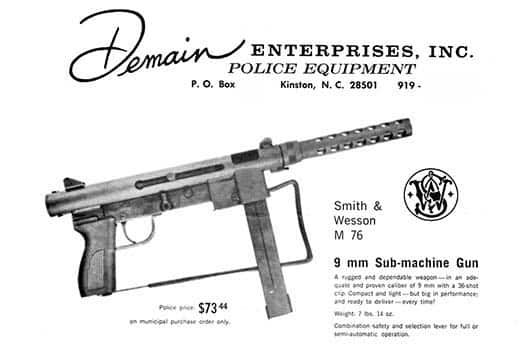By Frank Iannamico
Occasionally, someone will post an old “machine guns for sale” advertisement from the 1960s on one of the popular Class III oriented internet boards, with the ads featuring unbelievably low prices compared to those encountered today. When a young enthusiast reads the ads, they often wish they could travel back in time.
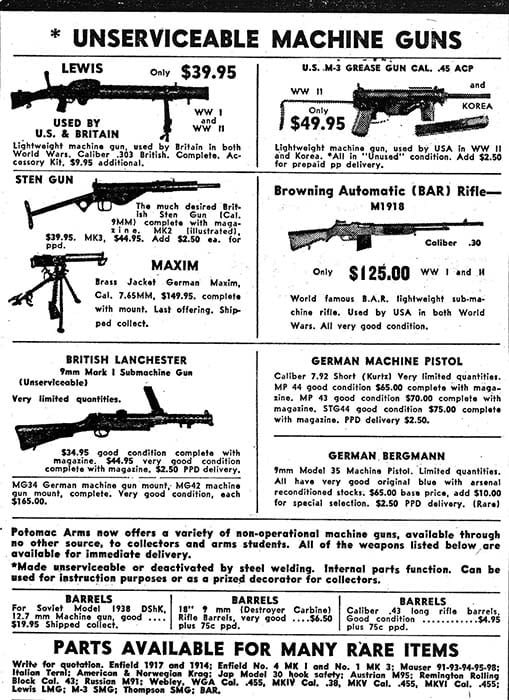
Well, it’s hard to believe today, but during the 1960s, 1970s and 1980s machine guns, although far less expensive, were not selling as quickly as they do currently. One reason for relatively slow machine gun sales in those days was that few knew the protocol of buying a machine gun or where to find one for sale. There was basically no single source of information on machine gun ownership. The subject of Class III firearms was largely ignored by the mainstream supermarket gun magazines. There were only a few dealers that dealt in Class III. For example, in 1965 there was a reported total of only three Class III dealers in the entire country. Probably the best known of the early dealers was the controversial Curtis Earl, through his catalogs and advertising. Mr. Earl predicted that machine guns would continually escalate in price. On the back of his catalogs was a bar graph titled Machine Guns Your Best Investment. The graph illustrated from 1965 to 1979 an increase of 2,080 percent in machine gun prices, with a yearly average increase of 149 percent.
One obstacle to the purchase of a machine gun was the $200 federal transfer tax. Few individuals had sufficient disposable income during the economic recessions of the 1970s and 1980s to pay $500 for an M16A1 rifle and an additional $200 for the transfer tax. Of course, there were many cheaper full-autos available; Sten submachine guns with new manufacture receiver tubes could be had for around $125 retail, and MAC-10s and Smith & Wesson Model 76 submachine guns were available for even less. However, the mindset of many at the time was “I’m not paying a $200 tax on a $125 Sten.” Although many, justifiably, complain about the astronomical machine gun prices today, the price is often what motivates the owner to part with a coveted machine gun. When their Colt M16A1 was worth $500 there was no viable reason to sell it. But today, with prices hovering in the range of a new automobile, many owners are motivated to sell. According to the Dollar Times, $500 in 1984 had the same buying power as $1,191.67 in 2017.
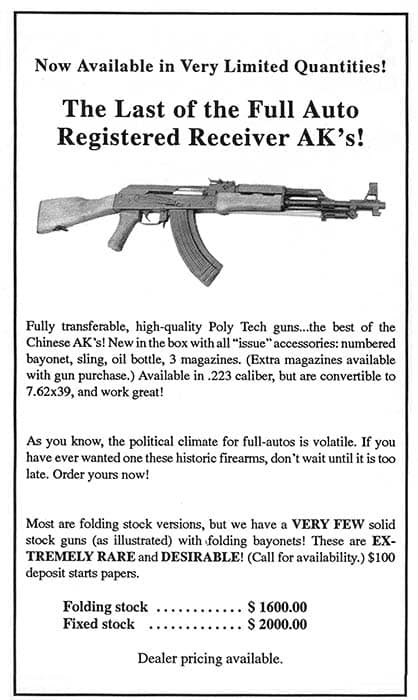
Although the internet is taken for granted today, in the old days most machine guns were found in the printed pages of the Shotgun News (now known as the Firearm News). There were three issues of SGN a month. Upon arriving in the mail, one usually would turn to the “machine guns for sale” section. When a suitable gun was found, the potential buyer had to CALL the person who placed the ad on a telephone to discuss the deal—email and texting did not yet exist. A plus side to this seemingly (to some) archaic method of communication was that there were far fewer scammers and there was more human contact. Fifty-fifty payment plans were common; 50 percent down started the paperwork, the remaining 50 percent was due when the transfer was approved. Prior to the internet, many in the U.S., including a few advanced firearm collectors, believed civilian possession of machine guns was illegal. Others thought that you had to be a Class III dealer. The Class III community was quite small, and many wanted to keep it that way.
Even before the exposure on the internet began to drive prices upward, machine guns very slowly increased in value. When an owner decided to sell his $125 Sten gun, he wanted to recoup the $200 transfer tax he paid. So, the $200 was often added to the selling price. Now the $125 Stens were selling for $325 plus a new $200 tax.
The May 19, 1986, Manufacturing Ban
On May 19, 1986, the future manufacture, conversion and registration of transferable machine guns was banned for private ownership. Many Class II manufacturers, knowing of the pending deadline in advance, worked overtime making and registering machine guns. Overnight, prices for a transferable machine gun doubled. Many predicted that the prices would continue to increase, but no one had any idea of just how high the prices would go.
Tube Guns, Rewelds, Dewats, Auto Sears, Sideplates and Conversions
Prior to the sharing of knowledge through Class III oriented publications and the internet, quite a few enthusiasts were unaware of the many different configurations of machine guns.
Tube Guns
During 1968, the importation (except for dealer sales samples) of intact machine guns into the U.S. was banned, thus ending the flow of many original guns. However, the importation of part kits, less receivers, continued. Prior to May 1986 a new receiver, or sideplate, could be manufactured and registered, then assembled with a parts kit into a working firearm.
The description of “tube gun” generally refers to a machine gun parts kit that has been assembled with a newly manufactured, non-original, receiver. Many who purchased MP40s, Stens and similar machine guns with a new-manufacture receiver often had no idea that the gun they bought was not an all-original example. All they knew was that they had bought a German MP40 or British Sten, for instance. While original MP40s and Stens have Curio and Relic status, tube guns do not.
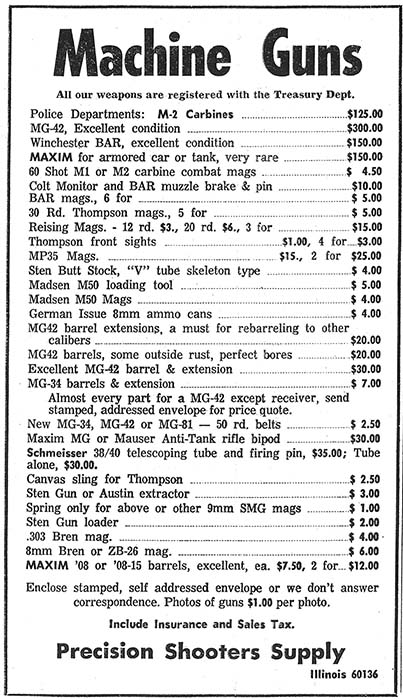
Rewelds
The term “reweld” is often applied to a receiver that was cut (demilled) into pieces and welded back together, often using donor sections of another cut receiver. The word “reweld” is often used to describe the process, but is not technically accurate; the receiver was only welded once after it was cut into pieces. Like the “tube guns,” guns with cut and welded receivers have also been purchased by many unaware that their gun’s receiver is not original. Commonly encountered cut and welded back together receivers are those from U.S. M14 rifles. One way to determine if a machine gun has a welded receiver is to check the registration form. If the form lists any manufacturer, other than one of the original companies, there is a good chance it has a welded receiver. However, some clever individuals have named one of the original companies on the form to misrepresent a gun that is not original. A welded receiver can be usually be spotted by a close examination under bright light. Clues are discolored areas, pinholes, slightly misaligned surfaces and evidence of grinding of the welds.
Amnesty Guns
During 1968, there was a brief amnesty to register any unregistered machine guns in the possession of a citizen. Many of the guns that were registered back then included a number of small arms brought home in duffle bags from World War II and Korea and more modern weapons from the Vietnam Conflict, like AKs and M14 rifles, which often bring mid five-figure bids at auctions. Unfortunately, many individuals with unregistered machine guns in their possession didn’t take advantage of the amnesty program, simply because they didn’t know about it or didn’t trust the government.
Semi-Auto to Full-Auto Conversions
During the 1960–1980 era, there was little interest in modern military firearms, save for M1 Garands, which at times were difficult to find. Interest was sparked when semi-automatic clones of military weapons, like the AR-15, HK 94, UZI, FN FAL and others, began to appear on the market. The semi-automatic versions differed in a number of ways from their full-auto counterparts to render their conversion to select-fire more difficult. The interest in the semi-automatic look-alikes in many cases led to an interest in the full-auto guns.
Prior to 1986, many semi-automatic versions of military weapons were converted to select-fire by Class II manufacturers and by a few individuals.
A question often posted on the internet boards when someone is searching, for example, an UZI submachine gun, is “what Class II manufacturer converted semi-automatic UZIs to correct submachine gun specs?” Well, the answer is, virtually none of them, for several reasons. For one, unlike today, there were few, if any, original UZI parts available. Another reason was that the retail price of a converted UZI prior to 1986 was roughly $700. The host UZI semi-automatic carbine cost around $400, so to maximize profit a manufacturer would use as many original semi-auto parts as possible. For example, converting the semi-auto trigger housing and shortening the original 16-inch semi-auto barrel to 10.5 inches.
The first semi-automatic AK rifles offered in the U.S. were made by Maadi and imported from Egypt in 1982. The guns were quite expensive at $1,150 to $1,500, and sales were slow. At that same time, a Colt AR-15 retailed for $400. The Maadi AK rifles had a rather low-quality painted finish, especially for a rifle that cost over $1,000 1982 dollars. Another major factor that affected sales was a lack of 7.62x39mm ammunition in the U.S.
Due to the small number imported, the Egyptian AK rifles are now considered collector guns and have greatly increased in value. Among the most sought after Egyptian AK rifles are those used in the 1984 Movie Red Dawn, especially those few that were converted to select-fire.
During 1984–1985 semi-automatic AK rifles began to be imported from China. Priced at around $300, they were quite a bargain for an AK. The AK was the rifle of the “bad guys;” many collectors in the U.S. had never even seen one before, except on TV. The early AKs from China were the stamped receiver models with a blued finish. Many of those who purchased them were somewhat disappointed, not being used to a firearm made of stamped sheet metal. The sales of Chinese AKs imported were brisk, selling much better than their Egyptian counterparts, due in part to a much lower price and the Chinese 7.62x39mm ammunition that was imported at the same time. Much of the earlier Chinese ammunition was corrosive, despite the ads and colorful boxes stating otherwise. A few shooters who were not familiar with the effects of corrosive ammo learned the hard way. Transferable AK rifles that were converted to select-fire are not common, due to the fact that few were in the country before May 1986, when conversions were banned. A few AK sears were made and registered, but they were confiscated when the ATF discovered that a hole needed to be drilled in the receiver to install them. Sears that were already installed were grandfathered on a case to case basis.
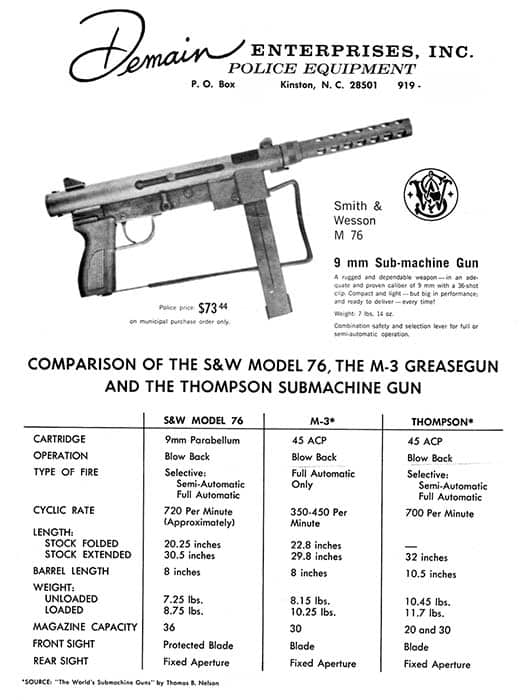
Auto Sears and Conversion Parts
Auto sears, lightning links, M2 carbine parts and certain trigger groups assemblies became “machine guns” after a government regulatory move to make all the drop-in conversions illegal unless they were registered. The government’s plan backfired when, prior to the 1986 manufacturing ban, Class II manufacturers began registering all types of parts as machine guns.
It is somewhat surprising how AR-15 and HK auto sears have escalated in price. AR-15 auto sears were once advertised as low as $29. In 1980, SWD’s AR-15 Lighting Links were $10 to $15, of course using an unregistered auto sear or lightning link to convert a semi-automatic to full auto was and is a felony, unless the device was registered. This could be done prior to May 1986 by an individual on a Form 1 and with a $200 transfer tax. Again, few were willing to pay a $200 tax on a $20 part. A few forward-thinking Class II manufacturers did register quite a few of them on a Form 2. Today, the price of a registered auto sear rivals that of a transferable Colt M16A1. Many enthusiasts prefer a transferable sear, because they can be used in any number of applicable rifles.
Part Sets and Magazines
Most of the part sets (less receivers) used to manufacture “tube guns” in the 1970–1980 period were harvested from World War II surplus weapons, like the Stens and MP40s. Although common today, many magazines and part sets were rare. For example, prior to the 1990s, imports from communist countries were banned. This meant no AK parts, magazines or ammunition from East Germany, Romania, Poland, Yugoslavia or Russia. No CZ rifles or pistols from Czechoslovakia. Communist weapons that were in the U.S. were strictly high-end collector items. Other weapons like the UZIs, HK91s and MP5s were still in service with many countries. They were not to be sold for parts just yet.
Ammunition
Ammunition prices have fluctuated over the years, due in part to availability. In the 1960s and 1970s, there were large lots of World War II surplus available, 8mm Mauser could be had for just pennies per round.
Like Communist firearms and part sets, Com Bloc ammunition was once very rare in the U.S.—7.62x39mm, 5.45x39mm and 7.62x25mm ammunition was usually only found in the stashes of advanced ammo collectors. AK 7.62x39mm ammo was hard to find, while 5.45x39mm for the AK-74 was non-existent. Now quite common, during the 1990s the price of Chinese 7.62x39mm was as low as $94 for a case of 1,440 rounds. During 2000, large lots of inexpensive 5.45x39mm ammo were imported.
At one time, .223/5.56mm ammunition was uncommon and expensive, and .308/7.62 NATO was comparatively cheap. That has changed with 7.62mm NATO selling for 60-cents-plus per round and .223/5.56 becoming more common and less expensive than it was 20 years ago.
| This article first appeared in Small Arms Review V21N8 (October 2017) |



